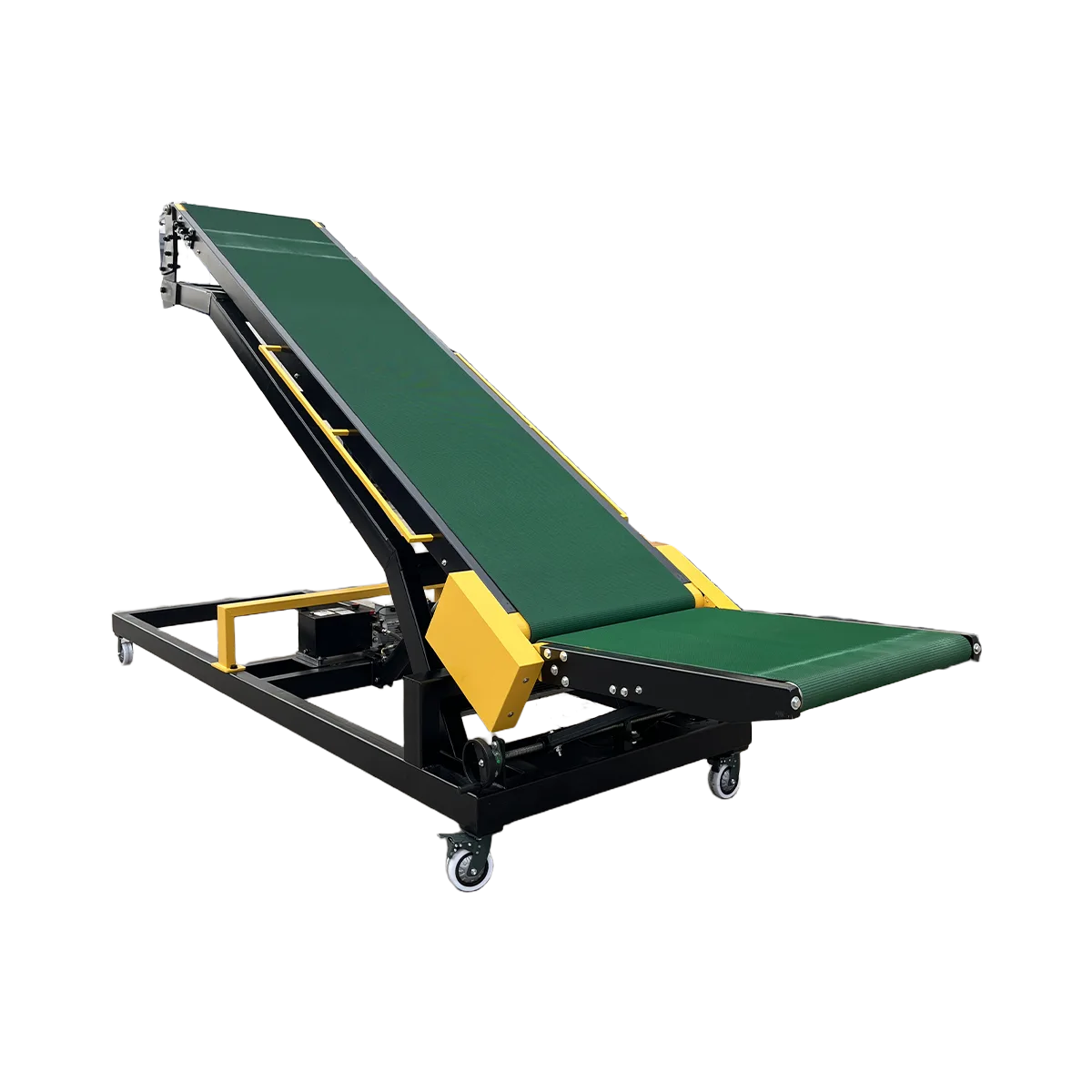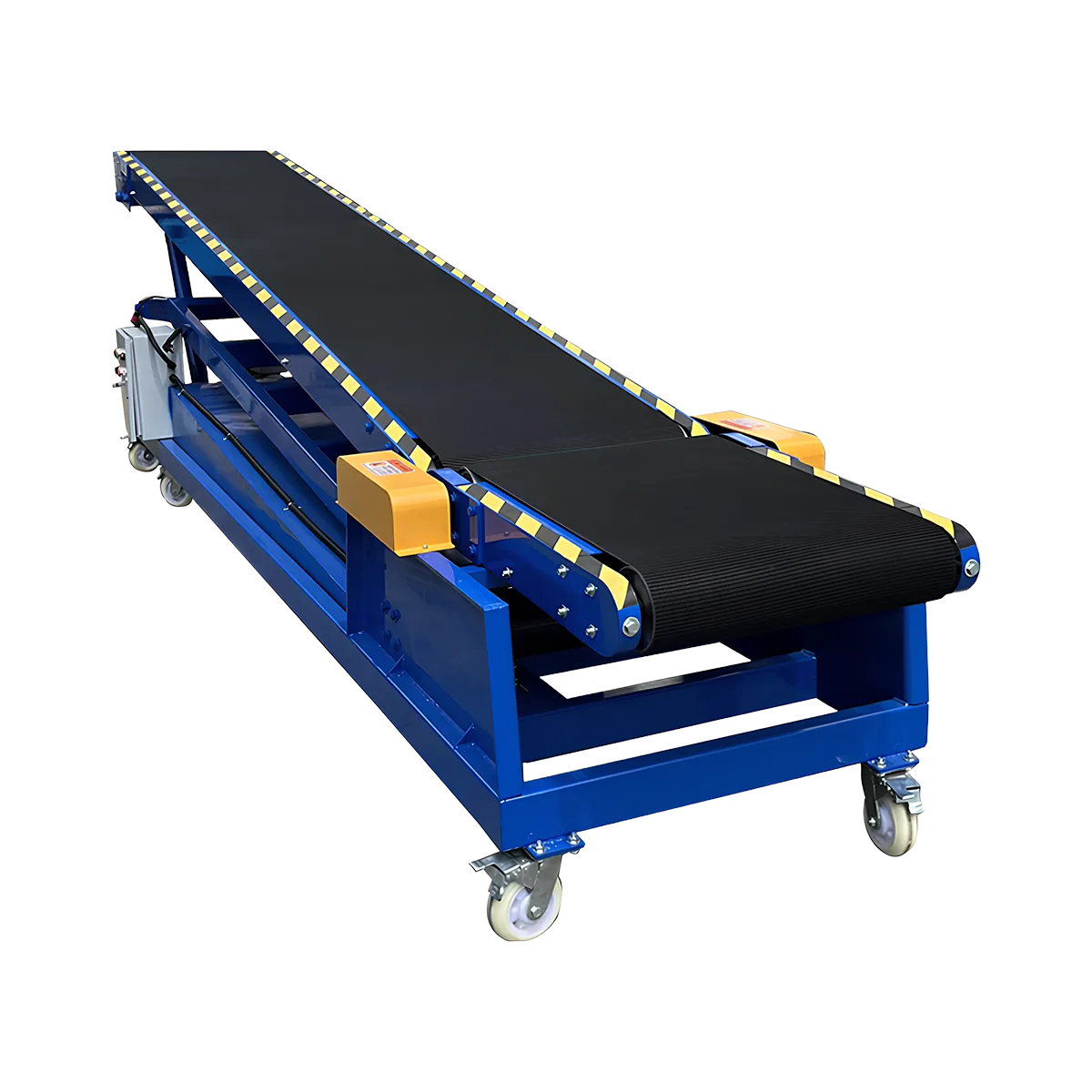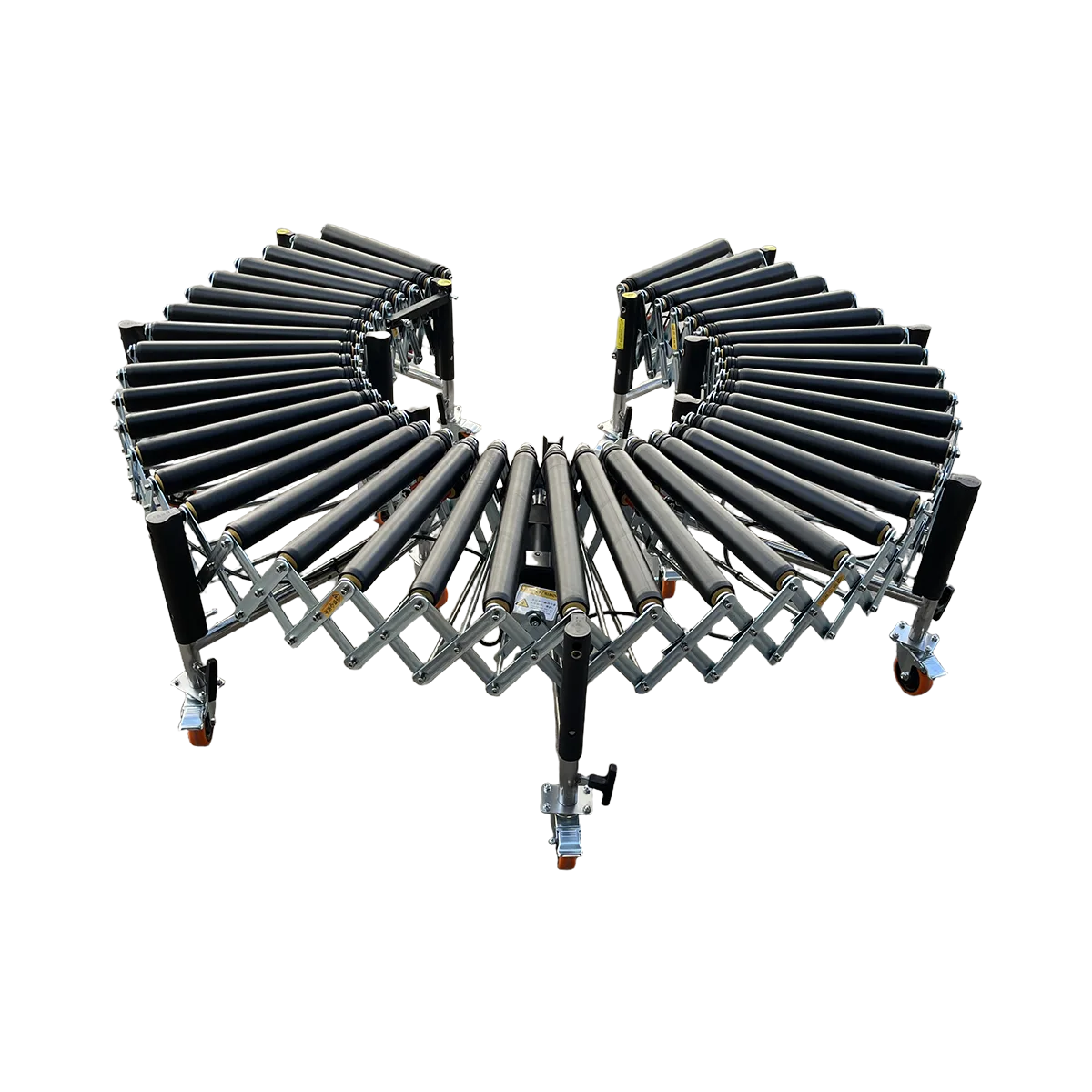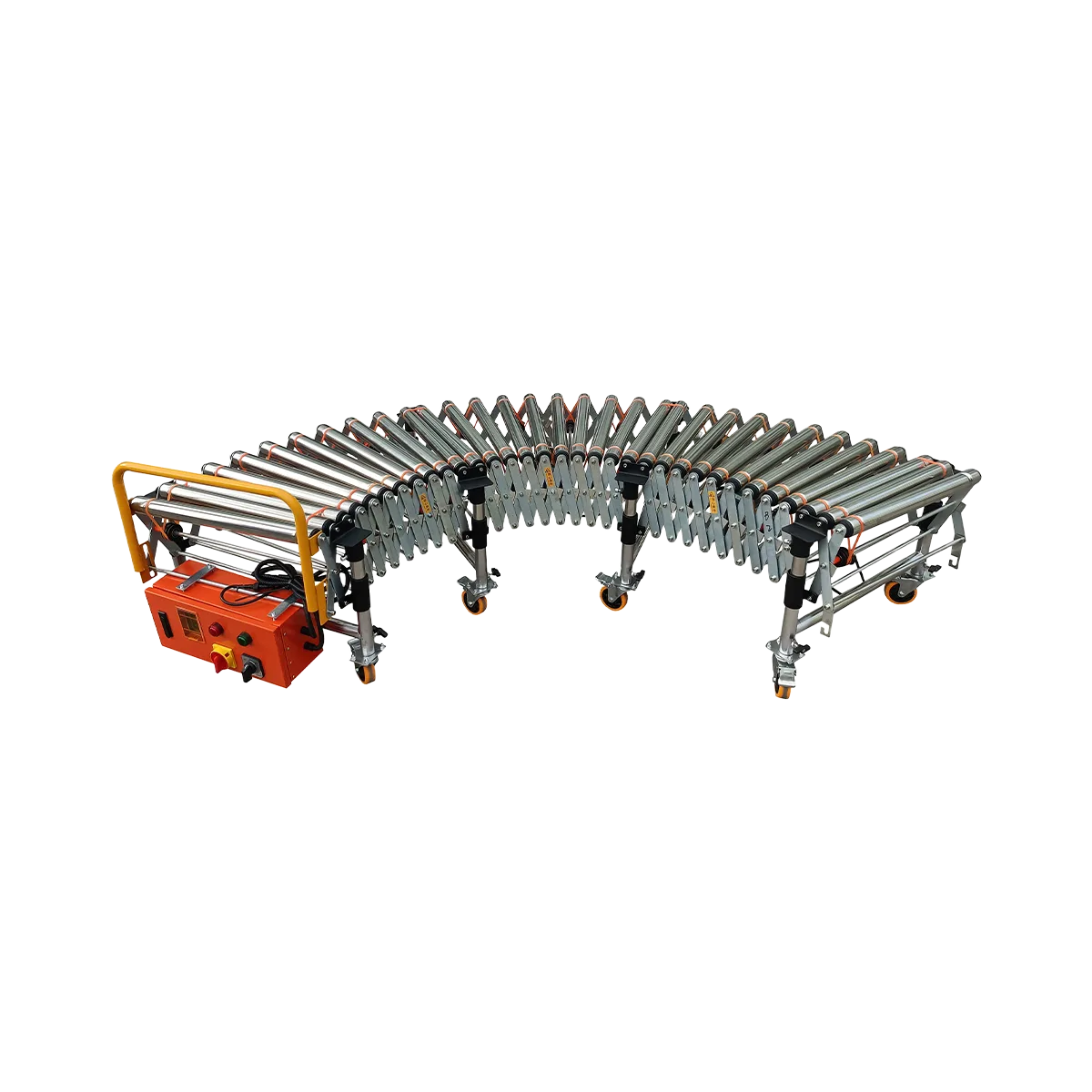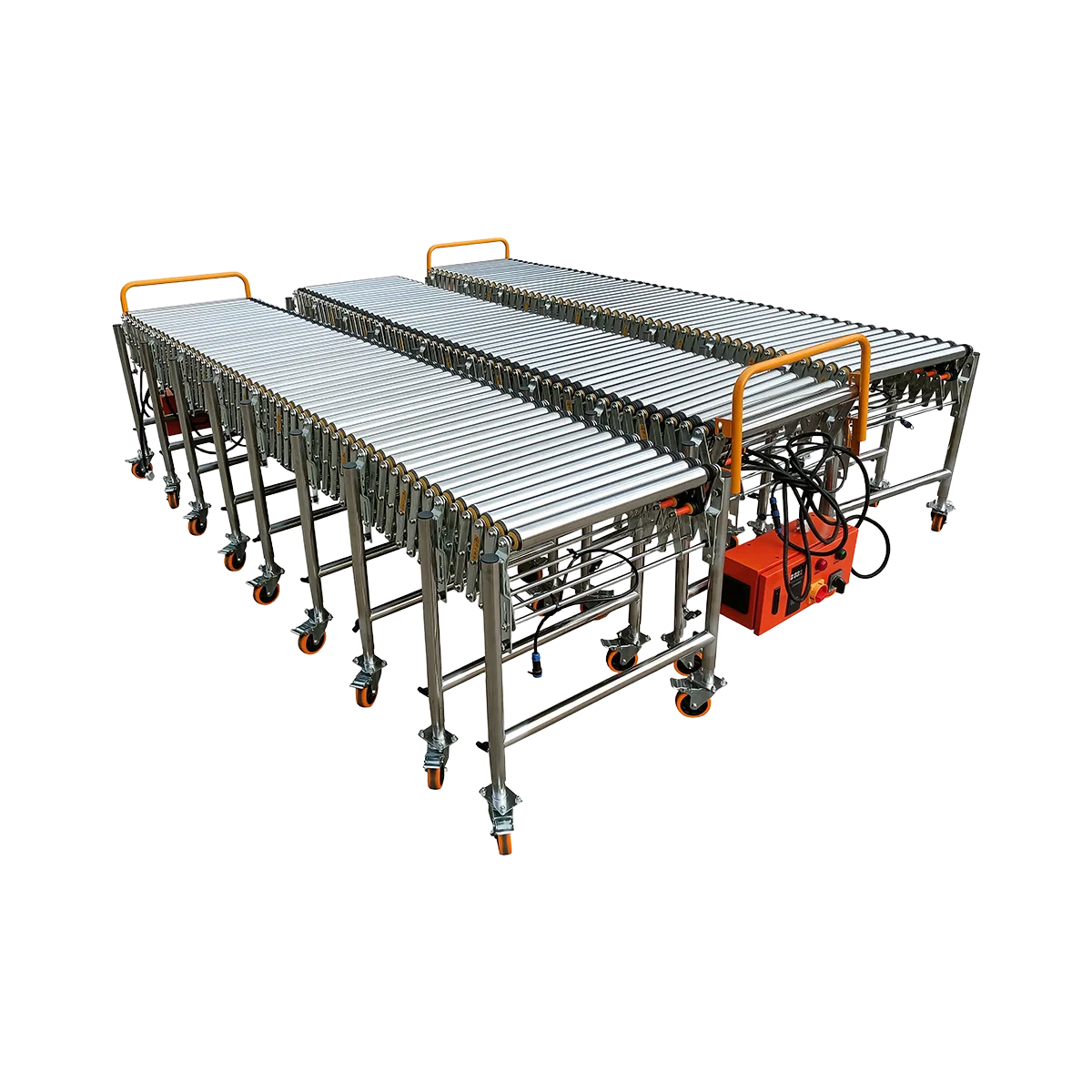Can One Person Unload a Truck with a Naili Conveyor System?
Discover how a one-person unloading system transforms logistics operations, making truck unloading more efficient while reducing physical strain and labor costs.
Related Products
-
Hydraulic Conveyor – Large – 7900 mm LengthCollapsed LengthExtended LengthLoad Capacity
80 kg/m
Applicable GoodsFlat-bottomed Goods
Bagged Goods
-
Hydraulic Conveyor – Medium – 7000 mm LengthCollapsed LengthExtended LengthLoad Capacity
80 kg/m
Applicable GoodsFlat-bottomed Goods
Bagged Goods
-
Powered Rubber Roller Conveyor – Multi-wedge Belt Driven – 1100 mm/SectionCollapsed Length
560 mm
Extended Length1100 mm
Load Capacity120 kg/m
Applicable GoodsFlat-bottomed Goods
Bagged Goods
-
Powered Roller Conveyor – O-shaped Belt Driven – 1500 mm/SectionCollapsed Length
525 mm
Extended Length1500 mm
Load Capacity80 kg/m
Applicable GoodsFlat-bottomed Goods
-
Powered Roller Conveyor – Multi-wedge Belt Driven – 2000 mm/SectionCollapsed Length
700 mm
Extended Length2000 mm
Load Capacity100 kg/m
Applicable GoodsFlat-bottomed Goods
-
Powered Roller Conveyor – Multi-wedge Belt Driven – 3000 mm/SectionCollapsed Length
1050 mm
Extended Length3000 mm
Load Capacity80 kg/m
Applicable GoodsFlat-bottomed Goods
The vision of a single worker efficiently unloading an entire truck is appealing to any logistics manager. In an era of labor shortages and rising operational costs, the concept of a one-person unloading system represents the ultimate efficiency goal for many warehouse operations. Imagine one employee handling the entire process: entering the truck, retrieving packages, transporting them into the warehouse, and properly positioning them—all without assistance.
This ideal scenario promises significant labor savings, simplified scheduling, and potentially faster turnaround times. But is this dream achievable with current conveyor technology? Can Naili conveyor systems truly enable a single person to perform what traditionally requires multiple workers? This article explores the reality behind the one-person unloading concept and how modern conveyor systems are transforming the efficiency equation.
The Reality: The Power of Two with Conveyor Support
While the dream of a completely solo truck loading conveyor operation is appealing, the reality is that optimal efficiency, safety, and ergonomics typically require two people working in conjunction with a properly designed conveyor system. However, this doesn’t diminish the revolutionary impact of modern conveyor systems on loading dock productivity.
Safety and Ergonomics: The Two-Person Advantage
The two-person approach with a conveyor system represents a fundamental improvement over traditional manual unloading methods:
- Eliminated carrying distances – Workers no longer walk packages from deep inside the truck to the warehouse
- Reduced twisting motions – Proper positioning at the conveyor minimizes harmful body movements
- Consistent work height – Properly adjusted conveyors keep work at optimal ergonomic levels
- Balanced workload – Tasks are distributed between two workers, preventing fatigue
- Enhanced safety oversight – Two workers can monitor each other and the equipment
The traditional method of manually unloading trucks often involves teams of 3-4 workers forming human chains or individuals making repeated trips in and out of the trailer. This approach results in significant physical strain, increased injury risk, and lower overall efficiency. By contrast, the two-person conveyor method dramatically reduces these issues while maintaining or improving throughput.
The Ergonomic Revolution
The key ergonomic improvements of the two-person conveyor system include:
| Traditional Manual Unloading | Two-Person Conveyor System |
|---|---|
| Repeated lifting and carrying over distance | Minimal lifting, sliding instead of carrying |
| Variable work heights from floor to ceiling | Consistent ergonomic work height |
| Twisting while carrying loads | Controlled movements in optimal positions |
| Walking on uneven trailer floors | Stationary positioning on stable surfaces |
| Fatigue from combined tasks | Specialized focus on single task |
These ergonomic advantages translate directly into fewer injuries, reduced worker fatigue, and sustained productivity throughout shifts.
Redefining the Work: Let the Conveyor Do the Traveling
The fundamental shift in the conveyor-assisted approach is that the mechanical system—not the workers—handles the horizontal transportation of goods. This completely transforms how unloading work is performed.
Person 1’s Role: Inside the Truck
The first worker, positioned inside the truck, has a streamlined role:
- Retrieve packages from their stacked position
- Turn and place them onto the conveyor (typically a telescopic conveyor extended into the truck)
- Maintain an organized workflow moving systematically through the trailer
- Focus solely on efficient retrieval without the exhaustion of carrying
This worker remains in a relatively fixed position, with the conveyor gradually extending deeper into the truck as unloading progresses. The physical demands are limited to lifting packages from their storage position and placing them on the conveyor belt—a significant reduction in effort compared to traditional methods.
Person 2’s Role: At the Warehouse End
The second worker, positioned at the warehouse end of the conveyor system:
- Receives packages as they exit the conveyor
- Sorts or directs them to appropriate locations
- Manages palletizing or further distribution
- Controls the conveyor speed if adjustments are needed
This worker also remains in a relatively fixed position, eliminating the need to enter and exit the truck repeatedly. The physical demands are limited to receiving packages from the conveyor and placing them in their next destination—whether that’s a pallet, sorting area, or connecting conveyor line.
The Conveyor’s Critical Role
The conveyor system itself becomes the third “team member,” handling what would otherwise be the most physically demanding aspect of unloading—horizontal transportation. Modern hydraulic conveyor systems can be precisely adjusted to the truck bed height, while extensible sections reach deep into the trailer, creating a continuous flow path from the farthest point of the truck to the warehouse floor.
The Efficiency Gain: Tripling Productivity with the Same Headcount
The most compelling aspect of the two-person conveyor system is its dramatic impact on productivity. While it doesn’t reduce the team to a single person, it significantly multiplies what two workers can accomplish.
Quantifying the Improvement
Research and field testing consistently show that a two-person team using a properly configured conveyor system can unload trucks approximately three times faster than a traditional two-person team using manual methods. This productivity multiplier comes from several factors:
- Elimination of walking time – In traditional unloading, up to 60% of worker time is spent simply walking rather than handling packages
- Consistent work rhythm – The conveyor creates a steady flow that eliminates stops and starts
- Reduced fatigue – Workers maintain higher productivity rates throughout their shifts
- Specialized focus – Each worker performs a specific role rather than multiple tasks
- Optimized package handling – Packages are touched fewer times between truck and final position
Real-World Performance Metrics
Typical unloading rates show the dramatic difference in throughput:
- Small parcels (up to 5kg): 3500-5000 pieces per hour with conveyor system
- Medium boxes (5-15kg): 2500-3500 pieces per hour with conveyor system
- Large cartons (15-30kg): 2000-2500 pieces per hour with conveyor system
- Heavy bagged goods (40-50kg): 1500-2000 pieces per hour with conveyor system
These rates represent 2-3 times the throughput of manual unloading methods with the same number of workers, effectively giving you the productivity of 4-6 workers with just 2 people.
The Economic Impact
The efficiency gains translate directly into economic benefits:
- Reduced labor costs – Complete unloading tasks with fewer total labor hours
- Faster truck turnaround – Process more trucks per day through the same dock
- Extended work capacity – Workers can handle more volume before fatigue becomes a factor
- Lower injury-related costs – Fewer ergonomic injuries mean reduced workers’ compensation claims
- Improved schedule reliability – More consistent unloading times enable better planning
For operations handling over 1000 packages daily, logistics conveyor systems typically achieve return on investment within 6-12 months through these combined savings.
Beyond Headcount: Reframing the Efficiency Question
While the original question asked if one person could unload a truck with a Naili conveyor system, perhaps the more valuable perspective is how conveyor systems transform what each worker can accomplish, regardless of team size.
Quality Over Quantity
Modern warehouse management increasingly focuses on optimizing the quality and sustainability of work rather than simply minimizing headcount. This approach recognizes several important factors:
- Worker retention – Providing proper equipment improves job satisfaction and reduces turnover
- Consistent performance – Properly supported workers maintain higher productivity levels
- Scalability – Systems can be adjusted for different volume requirements
- Flexibility – Workers can be reallocated to value-adding tasks rather than simple transport
- Safety culture – Demonstrating investment in proper equipment improves overall safety attitudes
The True Value Proposition
The most compelling reason to implement ergonomic warehouse solutions isn’t to eliminate positions but to multiply the effectiveness of each worker while improving their work experience. This creates a sustainable operation where:
- Workers experience less physical strain and fatigue
- Productivity remains high throughout shifts
- Injury rates and associated costs decrease
- Employee satisfaction and retention improve
- The operation can scale more easily with changing demands
These benefits create far more long-term value than simply reducing headcount by one person could ever achieve.
Choosing the Right System for Maximum Efficiency
To achieve the highest efficiency with a two-person unloading operation, selecting the appropriate conveyor system is crucial. The ideal setup typically combines multiple conveyor types:
For Truck-to-Dock Transfer
The primary interface between truck and warehouse requires specialized equipment:
- Telescopic conveyors – Extend deep into the truck and retract as unloading progresses
- Hydraulic conveyors – Provide height adjustment to precisely match various truck bed heights
For Warehouse Distribution
Once packages enter the warehouse, additional conveyor types can further enhance efficiency:
- Powered roller conveyor – Moves packages horizontally through the warehouse with controlled speed
- Gravity roller conveyor – Provides economical movement for shorter distances or declining paths
- Gravity skate wheel conveyor – Offers lightweight, highly flexible options for temporary setups
By combining these systems appropriately, the entire unloading process can be optimized from truck to final warehouse position.
Conclusion: Maximizing Human Potential Through Technology
While a Naili conveyor system doesn’t quite enable a true one-person unloading operation, it achieves something arguably more valuable: it makes a two-person team dramatically more productive while simultaneously improving their work experience. This represents the true promise of reducing labor in logistics—not eliminating workers, but multiplying what each worker can accomplish safely and sustainably.
The ideal approach recognizes that some tasks benefit from human judgment, dexterity, and adaptability, while others (like horizontal transport over distances) are better handled by mechanical systems. By allocating each task to its optimal performer—human or machine—the overall system achieves maximum efficiency.
For warehouse managers facing labor challenges, the focus should be on implementing systems that maximize the productivity and longevity of each worker rather than simply minimizing headcount. With properly implemented conveyor systems, a small team can achieve remarkable throughput while experiencing less physical strain—creating a win-win scenario for both operational efficiency and worker wellbeing.
Frequently Asked Questions
What is the minimum number of workers needed to operate a Naili conveyor unloading system?
A minimum of two workers is recommended for safe and efficient operation—one positioned inside the truck to place items on the conveyor, and one at the receiving end to manage incoming packages. While technically possible to operate with one person in some scenarios, this significantly reduces efficiency and increases safety risks.
How much faster is conveyor unloading compared to manual methods?
A two-person team using a conveyor system typically unloads 2-3 times faster than the same team using traditional manual methods. This efficiency gain comes primarily from eliminating walking time and creating a continuous flow of packages.
Can conveyor systems handle all types of cargo?
Naili conveyor systems are designed to handle most standard packaging types up to their specified weight limits (typically 50-100 kg/m depending on the model). Very large, irregularly shaped, or extremely heavy items (over 100kg) may still require special handling equipment like forklifts.
What is the return on investment period for a conveyor unloading system?
For operations handling over 1000 packages daily, conveyor systems typically achieve return on investment within 6-12 months through labor savings and efficiency improvements. The exact timeline depends on current labor costs, volume, and operational specifics.
Do conveyor systems require special training to operate?
Naili conveyor systems are designed for intuitive operation and do not require extensive training. Most workers can become proficient after a brief orientation to the controls and safety procedures. The equipment is designed to be straightforward to use, with simple controls for functions like speed adjustment and emergency stopping.
Table of Contents
Recent Posts
Discover how to select the perfect conveyor width for your warehouse operations. Our expert guide helps you match box sizes to conveyor dimensions for optimal efficiency and fewer jams.
Discover effective outdoor conveyor solutions for connecting warehouse to truck across open yards. Our guide to all-weather yard logistics will transform your loading efficiency.
Discover the ideal van loading conveyor solution for Sprinter, Transit and other delivery vehicles. Our Micro Hydraulic Conveyor system boosts efficiency while saving labor costs.

